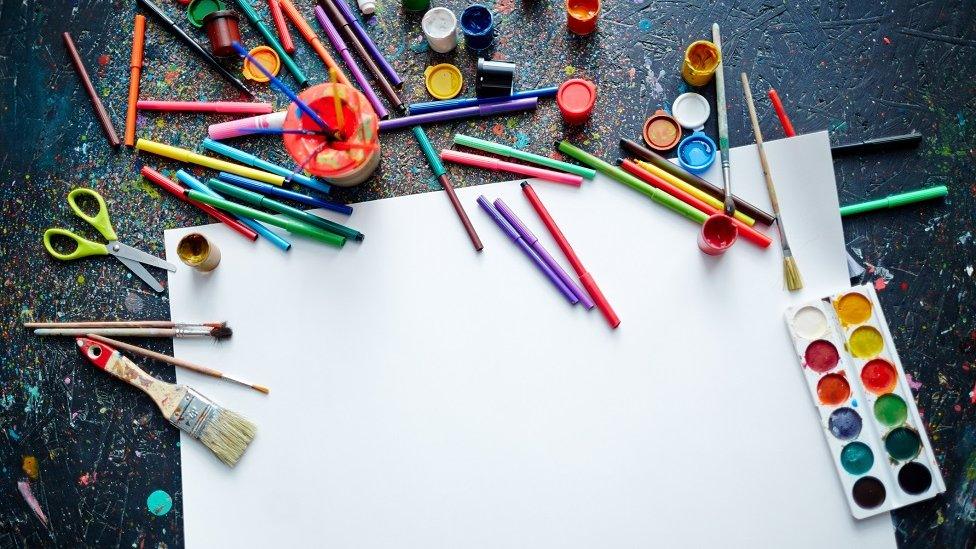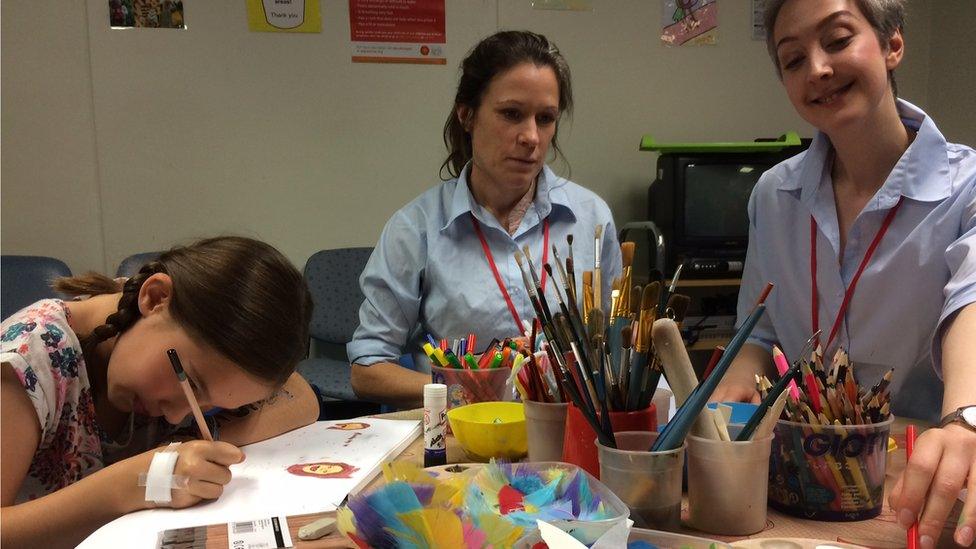Scottish charity offers art therapy to Grenfell Tower victims
- Published

One month after the devastating Grenfell Tower fire, charities are working with survivors to help restore a degree of normality.
Among them is The Teapot Trust, a Scottish charity which provides art therapy to child victims of trauma in hospital.
It was set up in 2010 by Laura Young whose daughter, Verity, had hated her frequent visits to hospital.
"She would kick, she would bite, she would scream," said Ms Young.
"If we got her into the car and said we're going to hospital, she would be trying to get out, and we got to the point where we were literally at our wits' end."
Gain confidence
She said they found art a distraction which later, after Verity died, also became a way of helping children cope with trauma.
"I hit on the idea of getting one of our babysitters who was actually studying art at the time to meet up at hospital so that the main focus of the visit to hospital wasn't that she was going to have her blood test.
"I'd say we're going to see Christina at the hospital and whilst you're there they might do your bloods.
"And it meant she could come with a picture and say this is what I did today."

Art therapists are working with children at the Sick Kids Hospital in Edinburgh
Now The Teapot Trust provides medical art therapists at hospitals and hospices in Scotland and London, helping children make something they can keep, gain in confidence and feel better able to cope - whatever their condition.
In one of the waiting areas of the Royal Hospital for Sick Children in Edinburgh there's a large table laden with art materials.
There are coloured felt tip pens, crayons and pencils, pots of paintbrushes, mounds of clay.
One of the art therapists is Shelly Kinloch. "They can just drop in and use the art materials however they want," she said.
"We also support them with building peer relationships and just trying to make the hospital experience a bit easier."
Paediatric art therapy is being offered to children caught up in the Grenfell tower tragedy, in which around 80 people died.
It is delivered on a one-to-one basis as well as in groups, giving the youngsters a chance to express themselves, help them feel more in control and learn how to cope with their situation.
Calming effect
Susan Rudnik is an art psychotherapist with The Teapot Trust working in London. She helped set up an art therapy space in a community centre close to the Grenfell Tower in the days after the blaze.
She said: "The children just have some art materials and they're free to do whatever they want to.
"That's been enormously helpful in this crisis and trauma whereby the children are just allowed a space to process their feelings through the art when words really aren't enough or even possible quite a lot of the time."
She added: "The tower features in a lot of their drawings because it's there, it's everybody's eye shot. It's in everything, it's everywhere we look, it's everywhere we go.
"But also there's a lot of other stuff, there's indescribable things, a lot of mess-making, a lot of stuff that's just processing which isn't pretty pictures or even horrible pictures, it's just something in the art materials themselves that really make it possible for the children to process some of their feelings in a very visceral way."
Back in Edinburgh, nine-year-old Wahaj, has been making a clay mask. He wants to give it to his cousin as a thank you present for fixing one of his games.
"I think it's better because if you sit there forever, it makes you feel bored," he said. "But over here when you're doing stuff, making stuff like masks is more fun."
Art therapist Eilidh Gilbertson said they have good results from their work.
"If something terrible's happened they can make an image that responds to that where they don't have the words to communicate.
"This calms them down, they get to work with other children, they get to work with materials, it can relax them and calm them down a little bit."